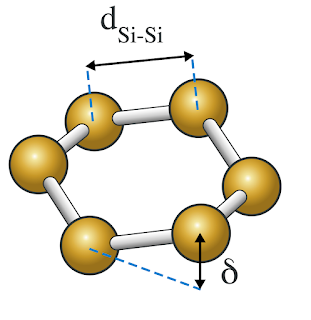Brian Clegg's Blog, page 13
August 17, 2024
Anyone for coffee?
 I hope you enjoy my online reviews and posts. These will always be free to read.
I hope you enjoy my online reviews and posts. These will always be free to read. But if you ever feel the urge to support my online work, you're very welcome to buy me a virtual coffee. You can do this using the button below, which will also be available at the bottom of each post.
Image from Unsplash by Nathan Dumlao.
See all of Brian's online articles or subscribe to a weekly digest for free here
August 16, 2024
Silicene revisited
 REVISIT SERIES -
REVISIT SERIES - A post from August 2014
Ten years ago I wrote about a new development in '2D' materials - a silicon equivalent of the wonderful graphene. As far as I can see, although research is ongoing as silicene has some potential benefits for making field effect transistors, we are yet to see much progress.
I'm not a great one for using press releases as blog posts (although, come on, it is the silly season), but this one was so interesting, I wanted to share it.
It's about silicene, which is the silicon equivalent of graphene, a single atom thick sheet of the substance. Just as graphene has proved an incredibly versatile material, the same is likely to prove true for silicene (which the spellchecker keeps trying to change to silicone - sigh). It's early days, but watch this space. Here's what the IoP had to say:
An international team of researchers has taken a significant step towards understanding the fundamental properties of the two-dimensional material silicene by showing that it can remain stable in the presence of oxygen.
In a study published on 12 August 2014, in IOP Publishing’s journal 2D Materials, the researchers have shown that thick, multilayers of silicene can be isolated from its parent material silicon and remain intact when exposed to air for at least 24 hours.
It is the first time that such a feat has been achieved and will allow scientists to further probe the material and exploit the properties that have made silicene a promising material in the electronics industry.
Silicene is made from single, honeycomb-shaped layers of silicon that are just one atom thick. At the moment, silicene must be produced in a vacuum to avoid any contact with oxygen, which could completely destroy the formation of the single layers.
Silicene must also be “grown” on a surface that matches its natural structure — silver is the leading candidate. To create silicene, a wafer of silicon is heated to high temperatures, forcing single silicon atoms to evaporate and land on the silver substrate, forming the single layer.
Silicene can also be transformed from a 2D material into a 3D material by stacking more and more single layers on top of each other. However, previous research has demonstrated that silicene has “suicidal tendencies” and always reverts back to silicon as more layers are added, because a silicon structure is more stable.
In this new study, an international team of researchers based in Italy and France fabricated multilayers of silicene using a silver substrate kept at a temperature of 470 K and a solid silicon source, which was heated to 1470 K. A total of 43 monolayers of silicene were deposited onto the substrate.
Once fabricated, the researchers observed that a very thin layer of oxidation had formed on top of the multi-layered stack of monolayers; however, it was shown that this preserved the integrity of the stack, acting like a protective layer.
The stack of monolayers remained preserved for at least 24 hours in open air, in which time the researchers were able to use x-ray diffraction and Raman spectroscopy to confirm that the material was in fact silicene and not ordinary silicon.
Lead author of the study Paola De Padova, from Consiglio Nazionale delle Ricerche in Italy, said: “These results are significant as we have shown that it is possible to obtain a silicon-based 2D material, which up until a couple of years ago was deemed inconceivable.
“Our present study shows that multi-layered silicene is more conductive than single-layered silicene, and therefore opens up the possibility of using it throughout the silicon microelectronics industry. In particular, we envisage the material being used as gate in a silicene-based MOSFET, which is the most commonly used transistor in digital and analog circuits.
“We are currently studying the possibility of growing multi-layered silicene directly onto semiconductor substrates to explore the joint superconducting properties.”
Image of silicene's buckled hexagonal ring from Wikipedia by Jozef Sivek, reproduced under CC3.0.
See all of Brian's online articles or subscribe to a weekly digest for free here
August 6, 2024
Murder at the Monastery - Richard Coles ***
 This is by far my least favourite of Richard Coles 'Canon Clement mysteries'. Let's get the negatives out of the way first. Coles has never been a great mystery writer - his success, particularly with
A Death in the Parish
(his best so far), was in his engaging description of village and church life in an old-fashioned 1980s parish, which is beautifully observed. But this entry in the series has the weakest murder plot so far - there really is no sense of trying to solve the mystery alongside the detective. Everything is hidden from the reader until the solution is revealed, while the motive and opportunity are both weakly conceived.
This is by far my least favourite of Richard Coles 'Canon Clement mysteries'. Let's get the negatives out of the way first. Coles has never been a great mystery writer - his success, particularly with
A Death in the Parish
(his best so far), was in his engaging description of village and church life in an old-fashioned 1980s parish, which is beautifully observed. But this entry in the series has the weakest murder plot so far - there really is no sense of trying to solve the mystery alongside the detective. Everything is hidden from the reader until the solution is revealed, while the motive and opportunity are both weakly conceived.The limited mystery content is usually compensated for by the excellent village/church life aspect - but here the main character has retreated (both literally and metaphorically) to the monastery where he was previously a novice, so the social aspects are much more bitty as Coles swaps between what's going on amongst the brethren, general village life, and the activities of the village gentry (plus the main character's mother). As a result nothing much develops in the village. We do see a fair amount of the monastic life, which is the most interesting part of the book - but it's hard not to compare this negatively with Ellis Peters' Cadfael novels which equally give a good feel for the cloistered life (if in a different period) while providing both satisfying mysteries and some history.
All in all it just didn't come together for me - it felt a bit like a 'the other two have been successful, let's rush another one out' book. Hopefully, Coles will develop the inevitable successor rather more effectively than this one.
See all of Brian's online articles or subscribe to a weekly digest for free here You can buy Murder at the Monastery from Amazon.co.uk Amazon.com and Bookshop.org
Using these links earns us commission at no cost to you
August 5, 2024
Whatever Happened to the Rocket Men?
 This morning I heard Elton John's Rocket Man and noticed the line about not understanding the science and it's just a job he has five days a week. It reminded me of a sociological oddity of early science fiction films. If you watch a film about spaceflight from the 50s, say, the crew almost always included a 'working man' type. If it's a British film he'd probably be a cheery cockney, while the US would give us a wise-cracking or cynical man of the people (they were always men).
This morning I heard Elton John's Rocket Man and noticed the line about not understanding the science and it's just a job he has five days a week. It reminded me of a sociological oddity of early science fiction films. If you watch a film about spaceflight from the 50s, say, the crew almost always included a 'working man' type. If it's a British film he'd probably be a cheery cockney, while the US would give us a wise-cracking or cynical man of the people (they were always men).The reasoning was pretty obvious - the filmmakers were basing their ideas of a spaceship crew on that of a traditional ship. Even Star Trek, despite starting well into the NASA era, fell for this idea - though they at least had a big enough crew on the Enterprise to require a whole range of roles. But those old, primarily black and white, films usually only had a small crew. So what were they expecting the role of the 'I don't know about the science, just do my job' person to actually be? Turn big brass valves with greasy rags?
I think part of the reason for this occurring to me was reading Adam Roberts' new marmite of a novel, Lake of Darkness, which explicitly mocks the way that most science fiction seems to base its model of future starships on the social structures of traditonal seagoing ships, and often military vessels at that.
You might think there was one other reason for putting in that 'man of the people' character - fulfilling the role that the companion traditionally takes on in Doctor Who. That's someone to ask what's going on and get an explanation from the more scientific types. But I don't particularly remember this happening in the old movies. Whatever the reason, these characters were an entertaining anachronism of their time.
Image (not M&S) from Unsplash by Andy Hermawan.
See all of Brian's online articles or subscribe to a weekly digest for free here
July 31, 2024
Innocent Blood - P. D. James ***
 This is an unusual novel from the late, great mystery writer P. D. James, first published in 1980. It is arguably a murder mystery in the sense of it's a novel that involves a murder and has some twists - but it is anything but a traditional mystery novel and does not feature James' detective Adam Dalgliesh at all (despite the US version being described as an Adam Dalgliesh mystery).
This is an unusual novel from the late, great mystery writer P. D. James, first published in 1980. It is arguably a murder mystery in the sense of it's a novel that involves a murder and has some twists - but it is anything but a traditional mystery novel and does not feature James' detective Adam Dalgliesh at all (despite the US version being described as an Adam Dalgliesh mystery).What we get instead is something between a Greek tragedy and a modern soap opera. This might seem an odd juxtaposition - but soap operas these days tend to put characters into terrible situations far more than the older kitchen sink versions. The main character in the book, Philippa Palfrey, is 18 and adopted (and possibly a sociopath). She feels she needs to know about her birth parents to discover who she is - but discovers that they were jailed for the rape and murder of a child. Her birth father is dead, but her mother is (conveniently) about to be released from jail. Add in the father of the murdered child, who has dedicated his life to killing Philip's birth mother on her release and we get all the elements required for such a tragedy.
It's an elegantly agonising scenario, brilliantly conceived. But I found a large chunk of it painfully slow - which is why I can only give it three stars. It's a novel in three acts. The opening one, where the situation is set up is excellent, as is the closing one, where everything comes to a conclusion with a couple of twists. But the long middle section spends far too long for me exploring the minutiae of Philippa's gradually getting to know her birth mother, the child's father planning his revenge, and (particularly) Philippa's adoptive mother living with her inadequacy.
All of this probably does work well as a literary novel - but I can't help but come at this with the expectation of a mystery writer's tight plotting and exposition, which really isn't there in that central section. Still a worthwhile read for any P. D. James lover, but decidedly an oddity.
See all of Brian's online articles or subscribe to a weekly digest for free here You can buy Innocent Blood from Amazon.co.uk Amazon.com and Bookshop.org
Using these links earns us commission at no cost to you
July 27, 2024
Sour? Doh!
 You might not think bread is the kind of thing where fashion is important - and it's not if you think of the more basic loaves. But get into the fancier end of the market (always more expensive, usually tastier and sometimes, but not always, healthier) and fashion reigns supreme. For some time now sourdough has been at the forefront of the fancier bread market, though wild flour is making some inroads, which is fine. But sourdough should be a choice, not inescapable.
You might not think bread is the kind of thing where fashion is important - and it's not if you think of the more basic loaves. But get into the fancier end of the market (always more expensive, usually tastier and sometimes, but not always, healthier) and fashion reigns supreme. For some time now sourdough has been at the forefront of the fancier bread market, though wild flour is making some inroads, which is fine. But sourdough should be a choice, not inescapable.The trouble is, I don't really like sourdough. I'm not particularly fond of its distinctive taste, the crust is way too hard - I always think I'm at risk of breaking a tooth on it - and it doesn't toast well, not starting to darken and crisp up until the crust is burning. We won't even mention those irritating holes that make it difficult to butter it or put jam on.
I have three corner shops, in the sense they are only 5 minutes walk away - Asda, Marks and Spencer, and Lidl. I particularly like the M&S bakery bread - their baguettes are the best I've had from a non-specialist baker outside of France. But they have gone sourdough mad. I'd say at least 75% of their fancier loaves are sourdough - and those that aren't are all white bread. The only wholemeal non-sourdough bread I can get from the bakery is a basic tin loaf.
I suspect sourdough is something of a bubble (get it?) in the marketing sense - at least, I hope so, and we can return to getting a better balance of fancier bread options for those of us who aren't dedicated followers of fashion.
Image (not M&S) from Unsplash by Mae Mu.
See all of Brian's online articles or subscribe to a weekly digest for free here
July 23, 2024
Weather wonders
 My latest book is out - Weather Science. We've had so many books on climate, but relatively few on weather. The distinction is often a puzzle, but it has been summarised in a neat little aphorism: 'climate is what you expect; weather is what you get'. If you look this up online it tends to be attributed to one of two US writers - Mark Twain and the twentieth century SF author, Robert Heinlein.
My latest book is out - Weather Science. We've had so many books on climate, but relatively few on weather. The distinction is often a puzzle, but it has been summarised in a neat little aphorism: 'climate is what you expect; weather is what you get'. If you look this up online it tends to be attributed to one of two US writers - Mark Twain and the twentieth century SF author, Robert Heinlein. Twain did write something a little similar 'Climate lasts all the time and weather only a few days' - but this lacks the effectiveness of the phrase above. Heinlein certainly used the wording in his treacly, 'wisdom'-laden, over-long late book Time Enough for Love, but this wasn't original. It's been suggested instead that it was first penned by Oxford geographer Andrew Herbertson in a 1901 textbook, though as is always the case with such sayings, it is entirely possible it was already in circulation well before that date.
Weather Science, then, takes a look at what we experience from the climate, whether it's the heavy duty stuff such as hurricanes and lightning or the gentler everyday possibilities of whether or not it will rain tomorrow. As well as the different weather phenomena it looks at forecasting and even attempts to modify the weather (on the whole rarely demonstrated with any certainty to work).
Here's a summary from the book's blurb:
Everyone has an interest in the weather, whether it's to check the prospects for a day out or to know when best to harvest a crop. The Earth's weather systems also provide some of the most dramatic forces of nature, from the vast release of energy in a lightning flash to the devastating impact of tornadoes and hurricanes.
For centuries, our only real guide to future weather was folklore, but with the introduction of the first weather forecasts and maps in Victorian times, attempts were made to give some warning of the weather to come. Until relatively recently, these forecasts could be wildly inaccurate - think of Michael Fish's denial that there was a storm on the way the night before the UK's great storm of 1987. This was due to the mathematically chaotic nature of weather systems, first discovered in the 1960s, the understanding of which would transform forecasting from the 1990s and mean that meteorologists became some of the foremost users of supercomputers.
From the crystalline perfection of the snowflake to the transfer of energy from the Sun, science lies at the heart of the weather and our understanding of it. In recent years, weather science has moved to the leading edge with advanced modelling, versatile use of satellite data and a better understanding of mathematical chaos. This is a true example of hot science at work.
See all of Brian's online articles or subscribe to a weekly digest for free here You can buy Weather Science from Amazon.co.uk Amazon.com and Bookshop.org
Using these links earns us commission at no cost to you
July 22, 2024
Revisiting the Dirac Sea
 REVISIT SERIES:
REVISIT SERIES:A post from July 2013 -
I've written two books about infinity, notably A Brief History of Infinity, and it's a subject I enjoy writing and thinking about. But for physicists, infinity often means a problem. While we can conceive that the universe might be infinite, because we only ever deal with a part of it, when infinity rears its head in calculations, it usually means trouble. This most famously arises in quantum electrodynamics, the science of the interaction of light and matter on the quantum scale. The solution there has been renormalisation - in effect, putting in the real observed values of some quantities to make the infinities go away. And this works, but it's a bit uncomfortable. Elsewhere, such as at the moment of the big bang or in the heart of a black hole, the infinities are taken to mean that our current theories break down at that point and we need to find new ways to look at what's happening.
However, there is another class of infinite entities that is tolerated by some, because they produce useful results, but that others find a little uncomfortable. Two examples spring to mind, both from the quantum world - the Dirac sea and the many worlds interpretation of quantum physics. I'd like to take a look at the less frequently covered of these, that unusual infinite ocean.
Paul Dirac was a superb (if rather strange) British physicist who was one of the leading lights in quantum theory, though he tends to be less well known in the outside world than the likes of Heisenberg or Schrödinger. (See Graham Carmelo's The Strangest Man for more on Dirac.) One of his crowning achievements was to extend Schrödinger's wave equation for some types of quantum particle, which describes the behaviour of those particles, so that it matches the real world. The original version was not relativistic - like Newton's laws it was an approximation that assumed particles moved fairly slowly. But an electron, for example, is often no slouch and it's Dirac's equation you need to keep track of it, not Schrödinger's.
However, something interesting emerged from Dirac's work. The equation has a kind of symmetry of solution that makes it equally possible to have positive and negative energy particles. Sometimes the negative parts of such equations have just been ignored. This happened most famously with 'advanced waves' - Maxwell's equations, describing electromagnetism and light, suggest there should be photons that travel backwards in time from destination to source as well as the usual forwards ones. These were simply ignored until Richard Feynman and John Wheeler realised they could be used to explain another oddity of physics. Dirac, though, did not simply cast his negative energy electrons away. But that led to a problem.
Light is typically produced when an electron drops an energy level. The electron loses energy and this is emitted as a photon of light. Eventually the electron gets to a 'ground state' below which it can't drop any more. But if negative energy levels were allowed, as Dirac's equation suggested, electrons should continue dropping in energy for ever, blasting out vast quantities of light. They don't. So Dirac came up with a the idea that the vacuum - empty space, if you like - contained an infinite sea of negative energy electrons, filling up all the negative energy levels, so your ordinary, everyday electron could never drop into negative energy.
This seems a very unlikely and highly wasteful proposition, requiring as it does this infinitely deep and wide sea of inaccessible particles. It rather typifies the subtitle of my book - 'the quest to think the unthinkable'. However it proved a very productive idea. The model predicts that there will sometimes be holes in the sea - gaps where a negative energy electron is missing. As it happens, a missing negative energy electron is identical to a present positive energy, positively charged equivalent of an electron. Dirac predicted these should exist, and a couple of years later, the positron was discovered. This hypothetical infinite negative energy sea enabled Dirac to predict the existence of antimatter.
Does the sea have any physical reality? That's a difficult one. Some physicists would say yes, while others would hedge their bets with philosophical waffle about the nature of reality. The fact remains that Dirac's infinite sea of negative energy particles has played a powerful role in the development of physics.
That's what I call a big idea. See all of Brian's online articles or subscribe to a weekly digest for free here
July 17, 2024
In the footsteps of Jocelyn Bell
 When I was in my last year at Cambridge, by which time my Natural Sciences degree had been refined down to experimental physics, I had to do a project. I had always been fascinated by radio astronomy, often passing Jodrell Bank on the way to a friend's house when at school: with a fellow student I was offered the chance to try some basic radio astronomy. We weren't given a handy, off-the-shelf, giant steerable dish, though. We had to start from scratch.
When I was in my last year at Cambridge, by which time my Natural Sciences degree had been refined down to experimental physics, I had to do a project. I had always been fascinated by radio astronomy, often passing Jodrell Bank on the way to a friend's house when at school: with a fellow student I was offered the chance to try some basic radio astronomy. We weren't given a handy, off-the-shelf, giant steerable dish, though. We had to start from scratch.One huge advantage I had in teaming up with Dave Izod (apologies if I got the name wrong - it was a long time ago) was that he had the huge advantage of being a (then) rare undergraduate with a car. The Mullard radio astronomy observatory was over four miles from my college and I didn't have a bike.
One of the reasons the exercise was so satisfying was that it involved picking up a whole range of new skills. The starting point, for example, was using a theodolite to determine levels before partially constructing and deploying an antenna that bore more resemblance to a bed frame than the familiar dish shape. There was then a whole host of measurements to be made before data could be collected and some attempt made at interpreting it (with a large amount of help from a patient grad student).
We did finally manage to pick up some radio signals and have a guess at what they were (sorry, analyse them), but what this brought home was the sheer indirectness of radio astronomy - particularly at a time when the technology employed was often so basic. This was as compared with modern equipment's ability to give you far more than just a list of numbers on a print out, which was all we got. I am totally in awe of Jocelyn Bell Burnell (at the time Jocelyn Bell) who had detected the first pulsars using equipment that was similarly basic (if much larger - see part of her 'array' illustrated above) less than 10 years before.
There is considerable controversy over Bell Burnell's lack of a share in the Nobel Prize - she herself has always been surprisingly sanguine on the matter, saying that she didn't think it was appropriate for research students to receive the Nobel 'except in very exceptional cases', which she didn't believe hers to be. However, I am more inclined to follow the lead of one of my other Cambridge-based astronomical heroes, Fred Hoyle who thought this was, indeed, an exceptional case and that her omission was more a matter of sexism on the part of the Nobel committee than anything else.
Whatever was the reality, working briefly, if on a toy project, at the Mullard was an amazing experience and hugely increased my admiration for those who have brought us such discoveries. Modern science writing often gives us a bit more a feel of the realities of scientific work - but I think radio astronomy is one field where we are so aware of the dish antennae that it's easy to forget what important work was done with a few wires, crude equipment, no computers and a lot of hard work.
Image: Part of the Cambridge Interplanetary Scintillation Array - c ourtesy of the Cavendish Laboratory, University of Cambridge.
See all of Brian's online articles or subscribe to a weekly digest for free hereJuly 16, 2024
The Baywatch principle revisited
 REVISIT SERIES:
REVISIT SERIES:A post from July 2012 - Science isn't always great at naming things. For every photon there are plenty of clunky names that don't do a lot for you. Take, for instance, the 'principle of least action', which sounds like a description of the lives of teenagers. This is a shame because it is really interesting. For reasons that will become clear I like to think of it as 'the Baywatch principle.' And what it says, in essence, is that nature is lazy.
French mathematician Pierre de Fermat used the principle of least action to explain why light bends as it moves from a thinner to a thicker substance (from air to glass, for instance) – and Richard Feynman made it a fundamental part of quantum electrodynamics.
The principle of least action describes why a basketball follows a particular route through space on its way to the basket. It rises and falls along the path that keeps the difference between the ball’s kinetic energy (the energy that makes it move) and potential energy (the energy that gravity gives it by pulling it downwards) to a minimum. Kinetic energy increases as the ball goes faster and decreases as it slows. Potential energy goes up as the ball gets higher in the air and reduces as it falls. The principle of least action establishes a balance between the two.
This principle is applied to light by considering time. The principle of least time says that light takes the quickest route. Fermat had to make two assumptions – that light’s speed isn’t infinite (the speed of light was yet to be measured in 1661 when Fermat produced this result), and that light moves slower in a dense material like glass than it does in air. We are used to straight lines being the quickest route between any two points – but that assumes that everything remains the same on the journey. In the case of light going from air to glass, bending is the quickest route. To see why this is the case, compare the light’s journey to a lifeguard, rescuing someone drowning in the sea. The obvious route is to head straight for the drowning person. But the lifeguard can run much faster on the beach than they can move in the water. By heading away from the victim, taking a longer path on the sand, then bending inwards and taking a more direct path in the water, the lifeguard gets there quicker.
Similarly, a light ray can reduce its journey time by spending longer in air and less time in glass. The angle that minimizes the journey time is the one that actually occurs.
When Richard Feynman was inspired by the principle of least action to come up with quantum electrodynamics, the theory that describes the interaction of light and matter so brilliantly, he imagined not just the one “best” path but every single possible path a particle could take in getting from A to B. At the heart of QED is the idea that you can identify the particles behaviour by taking a sum of every single possible path combined with the probability of that path occurring. See all of Brian's online articles or subscribe to a weekly digest for free here



